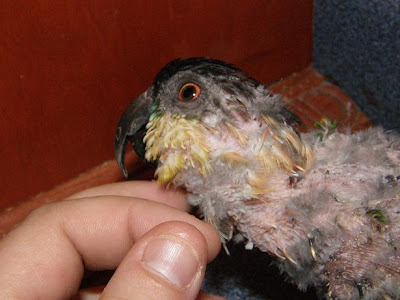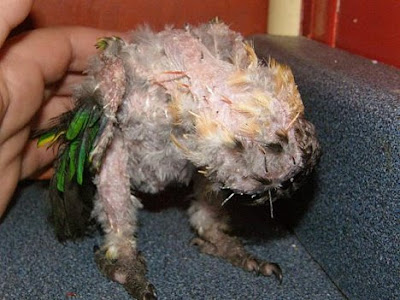
PBFD in Caiques: Tia's Story

"I got Tia from a breeder in December of 2006. This breeder had taken her in from a home where the owner died, but she attacked the husband and he did not want to keep her. Right from the time we got her, she was overly dependent on us - like she was lacking attention. She was moody and did not want to be removed from you. She played once in awhile, but not often.
I think I probably noticed something wasn't quite right from the beginning but I didn't look at it as sickness then, I thought it was a behavioural problem from being re-homed so much in such a short time."
That is how Delta, a parrot owner from Canada, describes how she and Tia first met. They had a close relationship from the start, but things quickly became clear as to why Tia was self mutilating.
"Later as things seemed to get worse, I noticed her reactions to things changing. When something would touch her, she would panic like it was going to kill her. She got moodier and cried if we touched her, like her skin was extremely sore. Most of her days and nights, when she was suppose to be sleeping, was instead spent pulling at herself and crying. She acted like she hated herself so much and wanted to hurt herself, but I now know that she must have been mentally exhausted from itching."
Tia's owner had no local resources, and suspecting this was more than just a case of feather plucking (which would have been bad enough), contacted a certified avian vet by email to ask his professional opinion. Here are a few of the photos she sent:
The avian vet quickly confirmed Delta's fears: this was a case of PBFD, or Psittacine Beak and Feather Disease. This illness is a deadly avian disease that, in it's early stages, may show no signs or symptoms. As it's name suggests, feather abnormalities and occasionally a deformed beak are some of the first signs that the bird may have this disease. Many infected birds will look and act perfectly normal for many years, although it is most common to manifest itself within the first 3 years of life. Unfortunately, PBFD is extremely contagious as viral particles are airborne, so no direct contact is necessary in order to infect another bird. The virus can attach itself to virtually anything; toys, feeding cups, seed/pellet mixes, used cages, nets, carriers, clothing, hair, ANYTHING. That means we should be very careful who and what we expose our pets to. In Tia's case, it is unknown where she may have been infected, but the effects were clear. Delta compassionately helped Tia to find some peace. On September 22, 2008 Tia was humanely put to sleep.*
"From what I know, she was 7 years old when she crossed over. Even though she was a challenge from the start, she was very dedicated to us. She may have attacked in the previous home but she accepted everyone in the household. She did not like strangers though and would bite. She didn't tend to want to be friends with the others either (feathered ones)... a very withdrawn bird.
She loved to surf like all Caiques do though. I have many shirts that she destroyed from chewing and surfing. She was special because she was Tia. She did not have the years she should have, and I was hoping to have spent many more with her. I have many birds whom I have dedicated to giving them the rest of their years with me - but I never intended for it to end so soon for Tia. I am so sorry she suffered the way she did and it is a terrible disease to see a feathered friend go through.
I miss her."
- As told by Tia's owner
*Not all birds with PBFD need to be euthanized, each case is individual. Many success stories have been reported of birds living with the disease. Recently, University of Georgia scientists have been working on finalizing development of a new vaccine that could effectively eliminate in companion bird populations the debilitating and often fatal disease. This vaccine would not be a cure, however, for already infected birds. Read more about the potential vaccine here.
Monday, October 06, 2008
|
Labels:
Health,
Parrot Stories,
Photos
|
EMAIL THIS POST|
Subscribe By Email:


Do You Own A Parrot?

Positively Perfect Parrot Pages!
- **Best In Flock**
- Brian's Angels
- The Beloved Parrot
- African Grey: Einstein!
- Einstein The Parrot Blog
- Heckled By Parrots
- The Finster Log
- Rainbow Parrots
- A Parrot For Keeps
- Feathered Friends Momentos
- The Answer Bird Blog
- The Pionus Point Of View
- Parrot Musings Blog
- Caique Crazy Blog
- Parrot Chatter Forum
- Fun In Flatland
- The Caique Forum
- The Perch Forum
- Good Bird Inc.
- Parrot Trick Training
Nani's Vocabulary To Date:
Pretty Girl
What Are You Doing?
(variation) Whatcha Doin'?
I Love You
Thank You
Look At You!
Peek-A-Boo
Chickie
What?
Come Here!
JoJo
Go Poo Poo
Uh Oh
Flip!
Hop!
I Don't Want You.









5 comments:
Oh, what a sad story. Poor Tia. Meow picks his feathers too, but thank god, it's not this disease. It's seasonal picking, hormonal I think. We've tried a lot of things -- this year I've changed his diet and he seems to be doing better.
Feather plucking is another big problem with companion birds. It's good to know Meow is doing better on his new diet. I think the hardest thing about these things is that we, as owners, feel completely powerless to stop the suffering.
Ain't that the truth. At least he looks good in spring and summer. And actually he's looking a little better this year. I think the diet is really helping.
Those pictures are just heartbreaking. Thanks for sharing this story!
I honestly don't know how I would cope with something like that. I can't even imagine how hard it must have been for Tia's owner.
Post a Comment